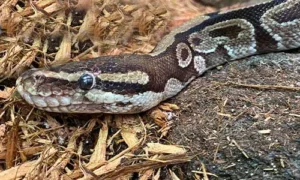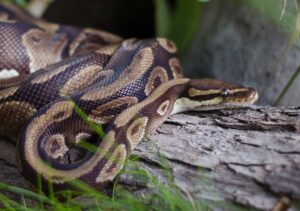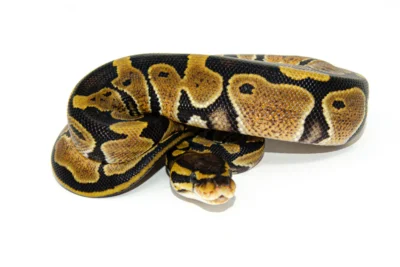One burning question that often ignites curiosity in the minds of snake enthusiasts is, “Do Ball Pythons Climb?” Join me as we unravel the secrets of these captivating creatures and discover whether these mesmerizing serpents have a penchant for scaling heights.
Yes, ball pythons are indeed capable climbers! While they might not be as arboreal as some other snake species, they possess the ability to climb trees and other structures. In their natural habitat, they may ascend trees to seek shelter, hunt for prey, or escape potential predators.
However, they are more commonly found on the ground or hiding in burrows. In captivity, providing them with branches or structures to climb on can offer enrichment and mimic their natural behaviors.
Do Ball Pythons Climb?

Yes, ball pythons are capable of climbing, although they are not as arboreal as some other snake species. In their natural habitat, ball pythons are primarily ground-dwelling snakes that can be found in grasslands and savannas. However, they may climb trees or shrubs on occasion.
In captivity, it’s not uncommon for ball pythons to explore and climb if given the opportunity. Providing branches, hides, and other climbing structures in their enclosure can encourage this behavior.
Keep in mind that while ball pythons can climb, they are generally not as proficient at it as some other snake species, such as arboreal pythons or tree boas. As with any snake, it’s important to provide a secure and well-designed enclosure to ensure their safety.
Physical Characteristics That Enable Ball Pythons Climbing
Ball pythons (Python regius) are known for their relatively calm demeanor and adaptability to different environments, including climbing. While they are not arboreal snakes, like some species, they do possess certain physical characteristics that enable them to climb. Here are some of the features that contribute to their climbing abilities:
- Prehensile Tail: Ball pythons have a muscular and prehensile tail that aids in grasping and holding onto objects. This tail adaptation allows them to anchor themselves while navigating branches or other climbing surfaces.
- Flexibility: Ball pythons are relatively agile and flexible. Their body is designed to move in a coordinated manner, allowing them to navigate through complex structures. This flexibility is especially useful for climbing in trees or vegetation.
- Scale Arrangement: The scales on a ball python’s belly are slightly keeled (ridged), providing a better grip on surfaces. This helps them maintain traction while climbing, preventing slips.
- Caudal Luring: Ball pythons are known to use a behavior called “caudal luring” where they wiggle their tail in a way that might attract prey. This behavior is also observed when they are climbing, and the movement of the tail can aid in maintaining balance and stability.
- Muscular Strength: Ball pythons have strong muscles, particularly in the midsection, which allows them to move with control and strength. This strength is beneficial for climbing vertically or across branches.
- Head Shape: Ball pythons have a relatively small and streamlined head, which allows them to navigate through tight spaces while climbing. This feature is especially useful when moving through branches or vegetation.
While ball pythons can climb, they are not primarily arboreal snakes. In the wild, they are often found on the ground or in burrows. In captivity, providing branches, hides, and other structures in their enclosure allows them to express their natural climbing behavior.
However, care should be taken to ensure that any climbing structures are secure and safe to prevent injuries to the snake.
Signs of a climbing-enthusiastic ball python
While ball pythons are not primarily arboreal snakes, some individuals may exhibit a preference for climbing. Not all ball pythons share the same behavior, as individual personalities can vary.
Here are some signs that your ball python might be climbing-enthusiastic:
- Utilizing Elevated Hides: If your ball python regularly uses elevated hides or hides that are situated above the ground level, it could indicate a climbing preference. This might include hides positioned on elevated branches or other structures within the enclosure.
- Exploring Vertical Space: Climbing enthusiasts may spend more time exploring vertical spaces within their enclosure. This could involve moving up and down branches, climbing on decorations, or investigating elevated platforms.
- Hanging from Branches: Some ball pythons may hang from branches or other climbing structures. This behavior is more commonly associated with arboreal species, but if your ball python exhibits this, it suggests a fondness for climbing.
- Perching: Climbing enthusiasts might adopt a perched position on branches or other elevated surfaces. They may use their tail to anchor themselves while resting or observing their surroundings.
- Frequent Use of Climbing Structures: If you provide branches, vines, or other climbing structures in the enclosure, a climbing-enthusiastic ball python will likely use them regularly. They may explore these structures even if they don’t lead to a hiding spot.
- Active at Night: Ball pythons are nocturnal, and climbing enthusiasts may be more active during the night. They might use this time to explore and climb around their enclosure.
It’s essential to observe your individual snake’s behavior and preferences to understand its unique personality. Some ball pythons may show a strong interest in climbing, while others may prefer to stay closer to the ground.
Providing a well-enriched environment with opportunities for climbing, hiding, and exploring can cater to a ball python’s natural instincts and contribute to its overall well-being. Additionally, always ensure that any climbing structures are secure and safe to prevent injuries to the snake.
Benefits of Climbing for Ball Pythons

While ball pythons are not primarily arboreal snakes, providing opportunities for climbing in their enclosure can offer various benefits to their physical and mental well-being.
Here are some potential advantages of incorporating climbing structures for ball pythons:
- Physical Exercise: Climbing encourages movement and exercise, promoting muscle development and overall fitness. This physical activity is essential for maintaining a healthy weight and preventing obesity, which can be a concern in captive reptiles.
- Environmental Enrichment: Climbing structures contribute to environmental enrichment by diversifying the snake’s living space. The inclusion of branches, platforms, and hides at different heights provides mental stimulation and encourages natural behaviors, preventing boredom.
- Thermoregulation: Climbing allows ball pythons to access different temperature zones within the enclosure. In the wild, they may climb to bask in the sun or seek cooler spots. Mimicking these temperature variations in captivity enables the snake to regulate its body temperature effectively.
- Behavioral Expression: Climbing is a natural behavior for many snake species, even if they are not strictly arboreal. Allowing ball pythons to climb lets them express their natural instincts and behaviors, contributing to a more fulfilling and stress-free environment.
- Improved Muscle Tone: Climbing engages various muscle groups, including those in the body and tail. This activity helps maintain muscle tone and flexibility, promoting a healthier and more active snake.
- Enhanced Hide Options: Elevated hides and climbing structures offer additional hiding spots. Ball pythons, known for their love of hiding, may appreciate having more options at different heights, contributing to a sense of security.
- Observational Opportunities: Elevated positions enable ball pythons to observe their surroundings more effectively. This can be enriching for them, allowing them to feel more in control of their environment and reducing stress.
- Natural Exploration: Climbing structures encourage natural exploration behavior. Ball pythons, like many reptiles, are curious creatures. Providing opportunities for them to climb allows them to investigate their surroundings, promoting a more active and engaged lifestyle.
When incorporating climbing structures into a ball python’s enclosure, it’s crucial to ensure that the structures are secure, stable, and safe.
In addition, branches, vines, and other climbing elements should be positioned to prevent any risk of injury, and they should be easy to clean to maintain a hygienic environment. Additionally, observe your snake’s behavior to determine its preferences and adjust the enclosure accordingly.


